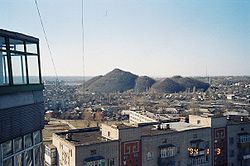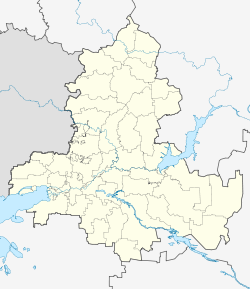Shakhty
| Shakhty (English) Шахты (Russian) |
|
|---|---|
| - City - | |
 A view of the city from the KhBK (cotton plant) area |
|
 Location of Rostov Oblast in Russia |
|
|
|
|
|
|
|
|
|
|
| City Day | Third Sunday of September |
| Administrative status (as of May 2011) | |
| Country | Russia |
| Federal subject | Rostov Oblast |
| Administratively subordinated to | Shakhty Urban Okrug |
| Administrative center of | Shakhty Urban Okrug |
| Municipal status (as of January 2007) | |
| Urban okrug | Shakhty Urban Okrug |
| Administrative center of | Shakhty Urban Okrug |
| Mayor | Denis Stanislavov |
| Statistics | |
| Population (2010 Census) | 239,987 inhabitants |
| - Rank in 2010 | 79th |
| Time zone | MSK (UTC+03:00) |
| Founded | beginning of the 19th century |
| Previous names |
Alexandro-Grushevskaya (until 1867), Gornoye Grushevskoye Poseleniye (until 1881), Alexandrovsk-Grushevsky (until 1920) |
| Postal code(s) | 346500 |
| Dialing code(s) | +7 8636 |
|
|
|
| on | |
Shakhty (Russian: Шахты; IPA: [ˈʂaxtɨ]) is a city in Rostov Oblast, Russia, located on the southeastern spur of the Donetsk mountain ridge, 75 kilometers (47 mi) northeast of Rostov-on-Don. As of the 2010 Census, its population was 239,987.
In the beginning of the 19th century sergeant-major Popov founded on the Grushevka River a Cossack stanitsa of Alexandro-Grushevskaya (Александро-Грушевская). While the exact reasoning behind this name is unclear, it is possible that the name was given in honor of Emperor Alexander I. Twelve Cossacks and fourteen peasant serfs lived in the stanitsa at that time. By the mid-19th century, fifty-seven coal mines operated in this area. In 1867, it was granted town status and renamed Gornoye Grushevskoye Poseleniye (Горное Грушевское Поселение). The name was changed to Alexandrovsk-Grushevsky (Александровск-Грушевский) in 1881.
By 1914, the population had reached 54,000. The main source of income was coal mining, which had been carried out in that region since the end of the 18th century. The population was poor, but the town had rail, telegraph and telephone networks, electricity and plumbing as well as libraries, hospitals and a post office. 1917 saw the city change hands three times, until it was taken on April 28, 1919, by the Don Army, under General Fitskhelaurov. For twenty months it was independent of the Bolsheviks, but was ravaged by typhoid.
In 1920, the city was given its present name. The name, which literally means mines in Russian, was chosen due to the strong association with coal mining. During the 1920s, many of the churches and the archives were destroyed. In 1928, the city was the location of the Shakhty Trial, a precursor of the show trials of the 1930s.
...
Wikipedia


